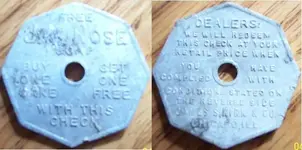Coffieman1
Tenderfoot
I was out with my son yesterday 4/9/06 and we went to an old abandoned farmhouse that was torn down and they are now taking the dirt away. Anyway too much ground clutter to get any good reads on the detector but my son found (with his eyes) a cool old time coupon for soap. Did some research on it and this is the only thing I have found so far.
James S. Kirk, a native of Scotland who grew up in Montreal, moved his soap-manu facturing business from Utica, New York, to Chicago in 1859. In 1867, he set up a large new plant on North Water Street. In 1870, this facility employed about 30 men and 20 children and made nearly $600,000 worth of soap during the year. By 1880, the North Water Street plant was one of world's largest soap factories, with machinery driven by steam engines, a workforce of 250, and an annual output worth over $2 million. By the turn of the century, when there were close 600 workers at Kirk's factory, it made about 100 million pounds of soap per year. In 1929, the North Water Street plant was demolished, and the remnants of the company were sold to Proctor & Gamble of Cincinnati.
James S. Kirk, a native of Scotland who grew up in Montreal, moved his soap-manu facturing business from Utica, New York, to Chicago in 1859. In 1867, he set up a large new plant on North Water Street. In 1870, this facility employed about 30 men and 20 children and made nearly $600,000 worth of soap during the year. By 1880, the North Water Street plant was one of world's largest soap factories, with machinery driven by steam engines, a workforce of 250, and an annual output worth over $2 million. By the turn of the century, when there were close 600 workers at Kirk's factory, it made about 100 million pounds of soap per year. In 1929, the North Water Street plant was demolished, and the remnants of the company were sold to Proctor & Gamble of Cincinnati.
Attachments
Upvote
0







